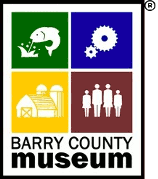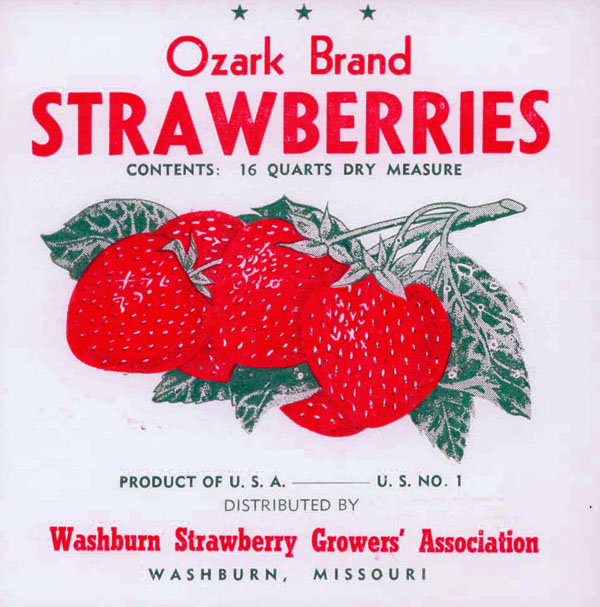 |
Label from Washburn Strawberry Growers' Association |
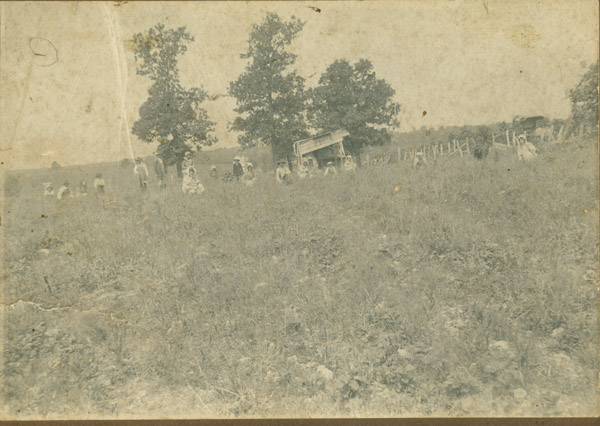
|
Arch Lewis Strawberry Patch at Exeter in 1912 |
"Just about the first commercial crop introduced in Southwest Missouri during the 1800s was strawberries. Growers Association told of a $1250 net profit taken from 7 acres of land which cost $175. During the heydays of strawberries, Exeter was one of the major growing and shipping centers in this part of the state. It is estimated that almost a million crates of the red fruit were shipped from Exeter between 1918 and 1953. Most strawberry growers had small acreages planted 2 to 3 to 10 acres. But through membership in the Exeter Berry Growers and Southwest Missouri Strawberry Growers Associations, the small growers were able to combine their shipments for the best possible price. These associations promoted the planting, picking, crating, and marketing of berries to the best advantage of the products. As the cost of labor became unprofitable for the small grower, berries as a commercial crop began to disappear during the 1950s. But even today, there are no better strawberries than those grown in the almost perfect soil and climate around Exeter." --The First 100 Years in Exeter |
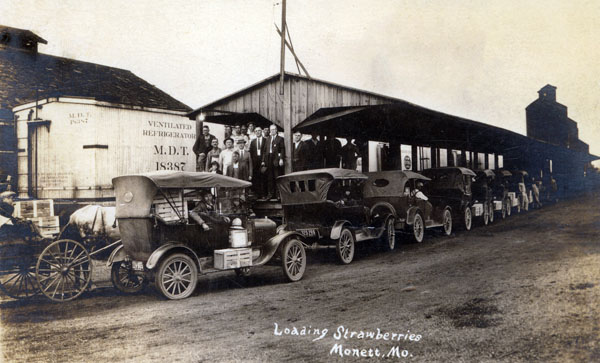
|
Loading Strawberries on the Frisco Railroad in 1920s Monett, MO |
Southwest Missouri produced the finest Strawberries in the United States and Monett became one of the busiest shipping centers for the Frisco Railroad. Berry sheds were located alongside the main line Frisco tracks. This area came alive during the strawberry season as the fruits of the picker's labor were brought to Monett to be placed in refrigerated cars to be shipped to points east, west, north, and south. As many as two to three hundred cars of the delicious red berries were directed to major cities throughout the Midwest. Local residents had the golden opportunity of buying the over ripe strawberries at bargain prices as they waited for the growers to sell their wares.
Growers belonged to Associations in most instances but some were large enough to handle their operations independently. The Ozark Fruit Growers Association operated from a two story brick building on Bond Street between Fourth and Fifth. The strawberries were a cash crop that added many dollars to the economy of the Ozarks region. Strawberry Festivals were common in southwest Missouri and northwest Arkansas. J. J. Sperandio was one of the bigger operators in the Monett area as he had fields in over one hundred acres located south and east of Monett. His patches covered four different locations and many pickers were hired to harvest his crop. -- Monett 1887-1987 |
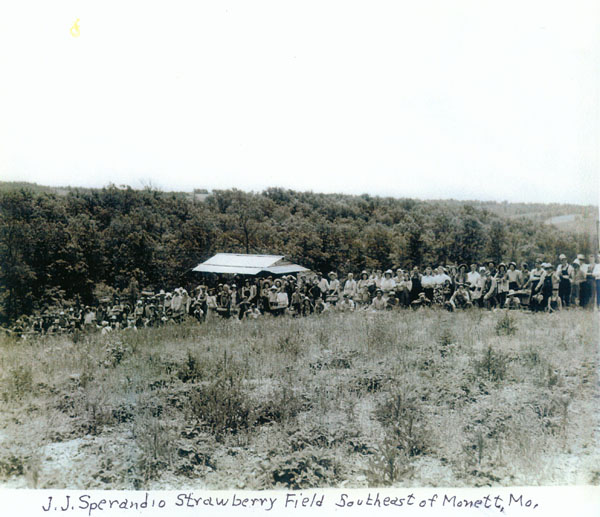 |
Strawberries by Russell A. "Gus" Tatum
A few days after the Twentieth century came to an end, a group of citizens from the Butterfield community met and decided to write some history on the events that happened in and around Butterfield, especially in the early 1900's. Since I was one of the larger strawberry growers of the Butterfield Community and the last secretary of the Butterfield Berry Growers Association, I agreed to write a short story on growing strawberries.
The Butterfield Berry Growers Association was organized around 1899 and operated every year until 1957. Most of the farmers in the area were having a very hard time back then making a living. Most of the families were large and just keeping food on the table was a major task and only making what they used to call a "Cornbread Living." In the winter, many would survive by catching rabbits and selling them for a dime or trapping fur animals. Some families had a cow or two and a few chickens. When the winter months were over, they were in desperate need of an early cash crop and strawberry was a crop that most all the family could take a part in and make a few dollars. Many years, the growers would start picking strawberries about the first of May and if we had rain, many times we would pick thirty days or more.
The children would get out of school around the first of May. The children that were eight years old or older would want to pick strawberries. This was a way for them to make some money to buy candy, soda pop, ice cream and for many, they would pay for their next year's school clothes.
Around 1915, when I was about nine years old, I picked strawberries for 2 ½ cents per quart. I could pick fifty or sixty quarts per day. When I quit growing strawberries, the Association price was three and one half cents per quart. The last week of the season, we would pay five cents per quart and we would have homemade ice cream for the pickers.
There were several different types of strawberries. Each had a different flavor. Some were small and some were very large, some were not good shipping berries. About ninety percent of the growers would grow the Aroma strawberry. The flavor was wonderful for making shortcakes.
There were so many farmers growing strawberries that we needed pickers from other states to come in and help pick our strawberries. Some families would start picking in Louisiana and when finished there, they would pack up their family in a covered wagon and come in to Arkansas, then on to Missouri. Some were called, "Hobos" because they would ride the freight trains. Most of them were good, honest people trying to make an honest living. Many of them had no homes. Some of the migrants had eight or ten children and this was a very hard life for them. Many would have to be taken out of school in order to make the trip. They would arrive broke, hungry and even their team of horses were in bad shape after the trip. After the government began to pay the older people a pension check each month, they had to have a permanent address. This stopped most of the "hobos."
Sometimes after a wagonload would arrive at my place, I would take them up to the store and tell the merchant to let them have enough groceries to get them by. They would always pay when they started picking the strawberries. Some of them would stay In their wagon, some in old sheds, some slept in the barn loft and some In old tents. Most of them seemed happy if their children were happy and had enough to eat.
Also, this was not always an easy life for the strawberry grower. He would have his share of troubles such as a late freeze or a hailstorm and his crops would be destroyed. The "old time" strawberry growers used to say, "If you don t like to work, don’t start growing strawberries." My strawberry fields were always near town and I took good care of them and usually had plenty of pickers. Yes, the old timers were right; it required a lot of hard work to grow strawberries. You would start setting the plants about the middle of March and it took about thirty five hundred plants to set one acre. You should plow them about ten or twelve times and cultivate them with a hoe four or five times. It would be about fourteen months before you would get your first paycheck. Henry Ford started building "Model T" trucks back in those days and sold them for less than five hundred dollars. A great many of these old "Model T's" were bought with strawberry money. Farm labor then was about ten cents per hour.
There were many towns in southwest Missouri that started growing strawberries. They would build a loading shed near the railroad track and soon, strawberry associations were organized. The berries were picked, and loaded on refrigerated railroad cars and shipped to all parts of the United States and Canada. There were twenty-four quarts to each crate and each car would hold four hundred and twenty crates. A broker would sell the strawberries for the association and mail the money back to the Secretary for the association. The Secretary would mail a check to the grower. The grower could draw a small amount on each crate in advance so his pickers could be paid. Some years, the strawberries would sell so cheap, it was hard for the farmer to survive and maybe the next year prices would be better and he could pay his bills, buy the Model T, maybe purchase a little more land. Then land sold for ten to fifteen dollars an acre.
There hasn't been strawberries shipped out of southwest Missouri since 1957. A few people grew strawberries just for their own use after that time. Today the farmer has machinery to do the work, many are growing cattle or chickens and driving expensive cars or trucks and land is selling for twelve to fifteen hundred dollars an acre. I've seen many changes over the last century in both living and farming conditions. -- Butterfield Community Then and Now
|
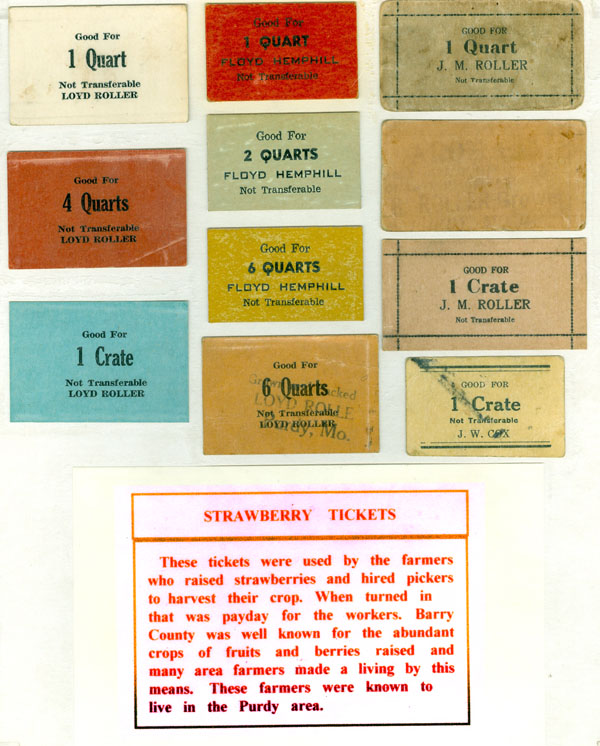 |
I Remember Strawberry Time by Barbara Rhea Baker
Along the railroad tracks there were the strawberry sheds. Each spring these became a very busy place as farmers delivered their fruit there each evening during the season to be labeled and loaded into refrigerated railroad cars for shipping to the city. Strawberry picking time was an exciting time. Many migrant pickers came into town and lived in tents usually pitched between the school house and the railroad tracks. All the local children and young people helped with the picking. The pay was one, two, or three cents per quart. This was usually our only chance to make any spending money. I can still remember the excitement that prevailed when at the last of the picking season we exchanged our strawberry tickets for cash. This usually bought a new dress or a pair of dress-up shoes. At least for a few days we were very happy planning what this wealth would buy.
Strawberry season did not last long, usually two or three weeks, but our little town boomed during this time. The farmers with loaded wagons, would begin lining up to deliver their crates of fruit to the sheds, about five o'clock in the afternoon. It was not unusual for wagons to be lined up as far as the cemetery and the last ones unloaded after midnight. For a town which was usually dark and quite by nine o'clock this was indeed different. When I was a high school girl my picture was used on the labels placed on each crate. The boys who worked, attaching these labels to the crates, often teased me about smearing paste on my face. I was never very pleased about that picture because I did not consider it very flattering. I must have been more pleased than I admitted for I still have one of the labels. -- Purdy, Our heritage in Story and Picture 1881-1981 |
| |
| |



